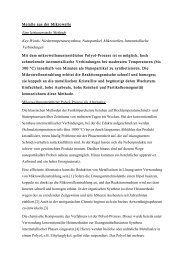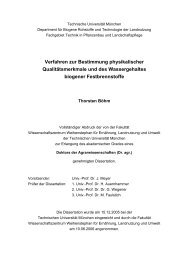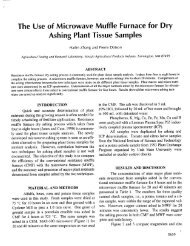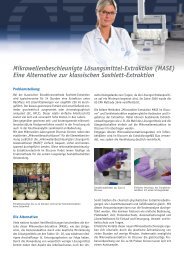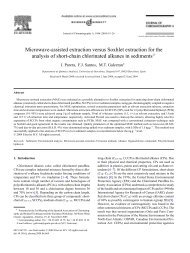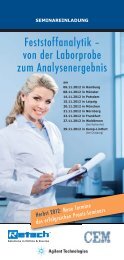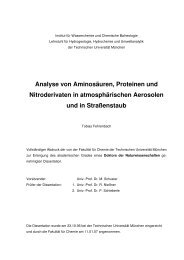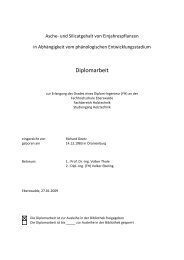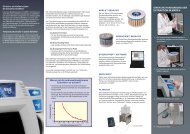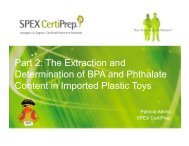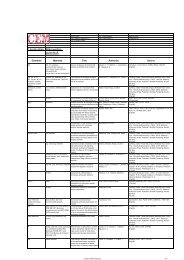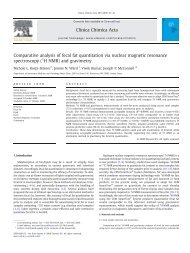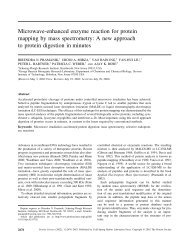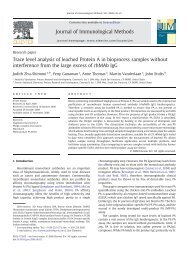Improved Synthesis of a Difficult Peptide by UV Monitoring
Improved Synthesis of a Difficult Peptide by UV Monitoring
Improved Synthesis of a Difficult Peptide by UV Monitoring
Create successful ePaper yourself
Turn your PDF publications into a flip-book with our unique Google optimized e-Paper software.
Page 1 <strong>of</strong> 3<br />
Application Note BIO-0011<br />
<strong>Improved</strong> <strong>Synthesis</strong> <strong>of</strong> a <strong>Difficult</strong> <strong>Peptide</strong> <strong>by</strong> <strong>UV</strong> <strong>Monitoring</strong><br />
INTRODUCTION<br />
The AKR/Gross murine leukemia viruses (MuLV)<br />
are C-type retroviruses that cause the<br />
development <strong>of</strong> leukemia in AKR (H-2 k ) mice. 1<br />
Type-specific antiretroviral cytotoxic Tlymphocyte<br />
(CTL) responses have been<br />
reported that allow differentiation between<br />
infection <strong>by</strong> the AKR/Gross MuLV and other<br />
MuLV. 1 A 10-mer derived from the C-terminal<br />
portion <strong>of</strong> the AKR/Gross MuLV CTL epitope has<br />
been used as a model “difficult” peptide for this<br />
study because it cannot be synthesized under<br />
standard conditions. 2,3<br />
<strong>UV</strong> monitoring <strong>of</strong> Fmoc deprotection allows the<br />
optimization <strong>of</strong> difficult syntheses. Typically,<br />
Fmoc removal is accomplished with piperidine,<br />
although other reagents such as piperazine may<br />
also be used. Piperidine reacts with the Fmocprotected<br />
amino acid to remove the Fmoc<br />
group (which is converted to dibenz<strong>of</strong>ulvene)<br />
yielding the free amine following<br />
decarboxylation (Figure 1). The dibenz<strong>of</strong>ulvene<br />
can then react with piperidine to form the<br />
dibenz<strong>of</strong>ulvene-piperidine adduct (DBF-pip).<br />
Figure 1. Fmoc removal <strong>by</strong> piperidine.<br />
The DBF-pip molecule shows a distinct <strong>UV</strong><br />
absorbance at 301 nm that is easily discernible<br />
from the background absorbance <strong>of</strong> the other<br />
reagents present in the deprotection reaction.<br />
Thus, <strong>by</strong> monitoring the <strong>UV</strong> absorbance at 301<br />
nm, the relative efficiency <strong>of</strong> a given<br />
deprotection reaction can be measured.<br />
When the <strong>UV</strong> spectrometer is connected to the<br />
Liberty/Liberty1, all liquid waste from the<br />
deprotection step flows through the <strong>UV</strong> flow<br />
cell, and the absorbance is measured. If the<br />
absorbance detected after the second (3 min)<br />
deprotection is above the set threshold, the<br />
deprotection is considered failed, and<br />
additional 3 minute deprotections are<br />
performed until either a passing value is<br />
obtained or a maximum number <strong>of</strong><br />
deprotections has been reached.<br />
In theory, a difficult deprotection will<br />
correspond to a difficult coupling. When using<br />
the <strong>UV</strong> <strong>Monitoring</strong> Option, the coupling<br />
conditions can be modified (double coupling,<br />
extended coupling time, and/or capping) on<br />
failure to compensate for this difficulty.<br />
MATERIALS AND METHODS<br />
Reagents<br />
All Fmoc amino acids and O-(Benzotriazol-1-yl)-<br />
N,N,N’,N’-tetramethyluronium hexafluorophosphate<br />
(HBTU) were obtained from CEM<br />
Corporation. PAL-PEG-PS resin was obtained<br />
from Applied Biosystems (Carlsbad, CA).<br />
Diisopropylethylamine (DIEA), piperidine,<br />
trifluoroacetic acid (TFA), triisopropylsilane<br />
(TIS), and 3,6-dioxa-1,8-octanedithiol (DODT)<br />
were obtained from Sigma Aldrich (St. Louis,<br />
MO). Dichloromethane (DCM), N,N-dimethylformamide<br />
(DMF), N-methylpyrrolidone (NMP),<br />
anhydrous diethyl ether, acetic acid, HPLC grade<br />
water and acetonitrile were obtained from VWR<br />
(West Chester, PA).<br />
<strong>Peptide</strong> <strong>Synthesis</strong>:<br />
WFTTLISTIM-NH2<br />
The peptide was prepared using the CEM<br />
Liberty automated microwave peptide
synthesizer equipped with the <strong>UV</strong> <strong>Monitoring</strong><br />
option, on 0.500 g <strong>of</strong> PAL-PEG-PS resin (0.20<br />
meq/g substitution). Deprotection (20%<br />
piperidine) was performed in two stages with<br />
an initial deprotection <strong>of</strong> 30 s followed <strong>by</strong> 3 min<br />
at 75 °C. Coupling reactions were performed<br />
with 5 fold excess Fmoc-AA-OH with 1:0.9:2<br />
AA/HBTU/DIEA for 5 min at 75 °C. For syntheses<br />
with <strong>UV</strong> monitoring, deprotection and coupling<br />
conditions were modified on failure as shown in<br />
Table 1.<br />
Table 1. <strong>UV</strong> monitoring conditions.<br />
<strong>Synthesis</strong><br />
Page 2 <strong>of</strong> 3<br />
Number <strong>of</strong><br />
Deprotections (Max)<br />
30 s 3 min<br />
Double<br />
Couple<br />
on Fail<br />
Extended<br />
Coupling<br />
on Fail<br />
1 1 1 No No<br />
2 1 3 No 15 min<br />
3 1 3 Yes 15 min<br />
Cleavage was performed using 92.5% TFA/2.5%<br />
H2O/2.5% TIS/2.5% DODT for 30 min at 38°C.<br />
Following cleavage the peptide was precipitated<br />
and washed in diethyl ether. <strong>Peptide</strong>s were<br />
lyophilized in 10% acetic acid prior to analysis.<br />
<strong>Peptide</strong> Analysis<br />
The peptides were analyzed on a Waters<br />
Atlantis C18 column (2.1 ×150 mm) at 214 nm<br />
with a gradient <strong>of</strong> 5 – 70% MeCN with 0.1% TFA,<br />
0 – 20 min, with the column heated to 40 °C.<br />
Mass analysis was performed using an LCQ<br />
Advantage ion trap mass spectrometer with<br />
electrospray ionization (Thermo Electron).<br />
RESULTS<br />
The MuLV CTL peptide was first synthesized<br />
under standard microwave conditions, yielding<br />
a crude purity <strong>of</strong> 37%. Deletions <strong>of</strong> F, W, T, and<br />
WT were observed (Figure 2).<br />
Application Note BIO-0011<br />
Figure 2. <strong>Synthesis</strong> 1 (Standard Conditions)<br />
The peptide was resynthesized with <strong>UV</strong><br />
monitoring, with a maximum <strong>of</strong> three 3 min<br />
deprotections, and extended coupling time (15<br />
min) on failure.<br />
Failures were observed for Thr 3 and Phe 2 (Figure<br />
3a), accounting for the deletions <strong>of</strong> F and W<br />
respectively. Target was obtained at a crude<br />
purity <strong>of</strong> 33%. The deletion products observed<br />
without <strong>UV</strong> monitoring were still present<br />
(Figure 3b).<br />
Figure 3. <strong>Synthesis</strong> 2 (15 min coupling on failure).<br />
a. <strong>UV</strong> absorbance data (failures indicated <strong>by</strong> *).<br />
b. HPLC data.<br />
-WT -W -T<br />
-F<br />
-W<br />
-WT<br />
-F -T<br />
Target<br />
* *<br />
Target
Finally, the peptide was synthesized with a<br />
maximum <strong>of</strong> three 3 min deprotections, and<br />
double coupling and extended coupling time<br />
(15 min) on failure. Failures were observed for<br />
Leu 5 , Thr 3 , and Phe 2 (Figure 4a), accounting for<br />
the deletions <strong>of</strong> T, F, and W respectively. Target<br />
was obtained at a crude purity <strong>of</strong> 88%. The F<br />
and W deletions were minimized, and the T and<br />
WT deletions were eliminated (Figure 4b).<br />
Figure 4. <strong>Synthesis</strong> 3 (15 min double coupling on<br />
failure).<br />
a. <strong>UV</strong> absorbance data (failures indicated <strong>by</strong> *).<br />
b. HPLC data.<br />
CONCLUSION<br />
<strong>UV</strong> monitoring is a powerful tool for the<br />
optimization <strong>of</strong> peptide synthesis, allowing<br />
access to peptides that were previously difficult<br />
to synthesize at high purity.<br />
Page 3 <strong>of</strong> 3<br />
-W -F<br />
*<br />
* *<br />
Target<br />
Application Note BIO-0011<br />
REFERENCES<br />
1. Green, W. R. Immun. Rev. 1999, 168, 271-<br />
286.<br />
2. Redemann, T., Jung, G. <strong>Peptide</strong>s 1996. In<br />
Proceedings <strong>of</strong> the 24 th European <strong>Peptide</strong><br />
Symposium; Ramage, R., Epton, R., Eds.;<br />
Mayflower Scientific Ltd: Kingswinford, UK,<br />
1998; p 749.<br />
3. Carpino, L. A., et al. Tetrahedron Lett. 2004,<br />
45, 7519-7523.



